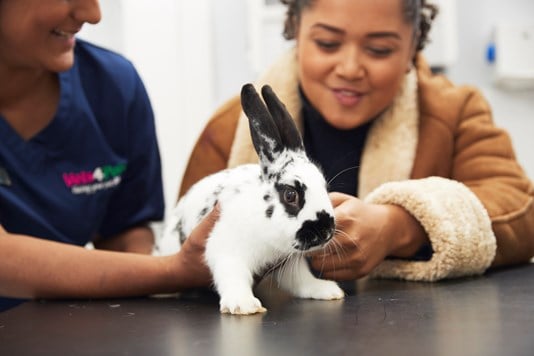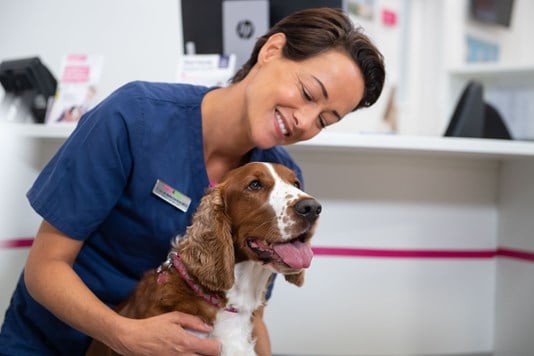
The vet guide to pet insurance
Purchasing pet insurance could be the single most important decision you make for your pet, so read our guide on pet insurance to make sure you find the right policy and insurer for you and your pet.
What is pet insurance?
Pet insurance is similar to the insurance you take out for your car, but it’s for your pet!
If you have a car accident and your car is damaged, you would claim on your car insurance for the cost of repairing your car. If your pet gets injured or becomes unwell, you would claim on your pet insurance for the cost of treating your pet.
Put simply, pet insurance helps cover the cost of veterinary treatment in the case of unexpected illness or injury.
Some policies also cover things like advertising and a finder’s reward in the event your pet goes missing or cattery/kennel fees should you have to spend time in hospital. Your pet insurance policy can also compensate you in the event of your pet’s death, or if they are lost due to theft or straying.
Many policies also offer third-party liability in the case of your dog injuring somebody or another dog, or even damaging or breaking someone else’s property. Not all policies are the same though, so check with your provider.
While the best scenario for your pet is that you never have to use your pet insurance, sadly pets can get into all sorts of mischief. Older pets especially are prone to a wide range of health problems so the vast majority of our pets will need veterinary treatment at some point in their lifetime.
Pet insurance gives you peace of mind, and when you do need it, it can be a lifesaver.
Do I need to have pet insurance?
We’re very lucky here in the UK to have the NHS, however the same service does not exist for our pet’s healthcare. This means that we, as pet owners, are responsible for paying for any veterinary care our pets may need.
Pet owners are often tempted to choose an alternative to pet insurance, particularly if they have had a pet before, paid to insure them and never needed to make a large claim. Some alternatives to insurance could be either paying for treatment for accidents and illnesses as they occur, using savings, credit cards or borrowing, or putting money aside every month into an ‘emergency fund’.
When considering how much money you should have available for emergencies, it’s worth thinking about your pet's age and breed – older pets and certain breeds can be more susceptible to certain health conditions, which will obviously require more veterinary care. A diagnosis of diabetes in your cat or dog could cost you upwards of £10,000 over your pet’s lifetime, and a complicated fracture repair can easily cost several thousand pounds.
So, if you choose not to insure your pet, it’s important that you have another means of covering the cost of any veterinary treatment. For a lot of us, these alternative options might not always be possible. That’s why we recommend insuring your pet as young as possible with lifetime cover.
Insurance top tips from the vets
The amount of cover for your pet will differ depending on your policy, so always check the wording carefully.
Most policies, however, will cover:
- Vet fees (up to the maximum policy amount), including some complementary treatments like hydrotherapy.
- Death of your pet (through illness or injury).
- Loss through theft or straying.
- Some policies may also go further and cover emergency boarding for your pet, as well as holiday cancellations if your pet is sick or injured.
- If you have a dog, your insurer may also cover third party liability.
Most pet insurance policies will not cover:
- Conditions that have already been diagnosed when the pet insurance was started.
- Routine healthcare such as vaccinations, or flea and worm treatments (if you would like to cover your routine healthcare via a simple direct debit, we recommend taking a look at our Health Plans, which are specifically designed for this).
There are many different policies, with some paying out very little for vet bills, with others as high as £12,000! When you choose your policy, make sure you read the small print to see how much your policy will cover you for.
It's really important to know the difference between your annual limit and your condition limit – some policies may have a large pot of money, but will only pay out a specified, smaller amount per condition, or will stop paying for a condition the first time the pot runs out. For example, your pet insurance policy may have an annual limit of £3000 but a condition limit of £500, which means that if the cost of treating your pet's injury was £1500, then you would only be able to claim £500 towards the treatment for this specific injury.
Some policies may also offer a large amount, but then stop paying once the policy is up for renewal, irrespective of how much money you had left.
Many people choose policies that:
- Offer lifetime cover which means that your pot of money can be used for all conditions every year, and the money in your pot for that condition ‘resets’ every year when you renew. This is very important for ongoing, chronic conditions such as diabetes or arthritis.
- The opposite of this is ‘annual cover’. Although both annual and lifetime policies have to be renewed every year, annual policies will NOT continue to pay for a condition after 12 months. At Vets4Pets, we recommend lifetime policies - this ensures that if your pet develops a long-term illness their treatment will be covered for the duration of their lifetime, as long as you continue to renew without a break in cover.
- Allow you to use all of your pot on all conditions if you need to. This is especially important if your pet has a very expensive condition, or needs specialist surgery or diagnostic equipment, which can come with a high price tag.
Pet insurance costs will vary hugely depending on a number of factors such as breed, age and the type of policy that you select.
Getting quotes from multiple insurers is a good idea, but make sure to take into account what they do and do not offer as part of the policy package – if a deal seems too good to be true, it probably is! Just because an insurance policy is less expensive, doesn’t mean that it’s the best option for you and your pet, so always read the small print before you commit.
Multi-pet policies can be cheaper per pet, but should only be considered if the policy options are suitable for all your pets.
It’s important that you pick a reputable insurer that is known for paying out claims.
If your pet is sick or injured and you have pet insurance, make sure to let your insurance provider and your vet practice know as soon as possible. Some insurance policies require you to notify them within a month of the start of a new problem, and in all cases sooner is better than later.
Your insurer will send you, or direct you to download, a claims form. This will have a section to be filled out by you and a section for your vet.
In some cases, the vet will be able to claim the money direct from the insurer, so you only have to pay out your excess. This is called a direct claim.
In other cases, you may have to pay your vet the balance of your pet’s treatment and then claim the money back from your pet insurance provider.
It's definitely worth speaking to the team at your local practice to find out how they manage insurance claims. Each veterinary practice will have their own policy when it comes to insurance and not all practices will accept direct claims.
For more information on how your local Vets4Pets works with insurance claims, please get in touch with them directly.
Case study
Barney is a 4-year-old, neutered poodle. His owner brings him to the vet as he has been drinking a lot more recently and looks a little thin.
Barney’s vet recommends blood and urine tests. Barney’s owner is happy for him to have the recommended tests.
Sadly, Barney is diagnosed with diabetes. This is a lifelong condition, and Barney will need medication every day for the rest of his life, as well as regular vet check-ups and blood tests. Barney is insured, but the type of insurance he has will greatly impact how much he will be covered.
- Barney has an Accident Only policy. Barney will NOT be covered at all for his diabetes, as it is an illness and not an accident. Barney’s owner will have to pay for all his tests, all his lifetime treatment and care.
- Barney has a Time-Limited policy. Barney’s policy will pay for his condition for 12 months after his diagnosis, up to the agreed cover amount (the covered amount of money will differ depending on the policy). After 12 months of Barney’s treatment and care being paid for (or at the time when the pot of money runs out, whichever is first), diabetes will be excluded from his insurance policy, and Barney’s owner will have to pay for Barney’s diabetes-related treatment and care from then on. Note: Barney will now no longer be able to be covered for his diabetes by any pet insurance, as it will be classed as a ‘pre-existing condition’.
- Barney has a Maximum Benefit policy. Barney’s care and treatment for his diabetes will be paid for until a set money-limit is reached (this limit depends on the policy). There is no time limit for this, but once the money has been spent, Barney’s diabetes will be excluded from his insurance policy, and Barney’s owner will have to pay for Barney’s diabetes-related treatment and care from then on. Note: Barney will now no longer be able to be covered for his diabetes by any pet insurance, as it will be classed as a ‘pre-existing condition’.
- Barney has a Lifetime Policy. Barney’s insurance will pay a set amount (the limit depends on the policy) for Barney’s diabetes every year. This pot of money will renew annually, and Barney’s diabetes will always be covered so long as Barney’s owner continues the policy with the same insurer every year. This is the most comprehensive policy and provides the fullest cover. Note: If Barney’s condition costs more per year than the annual insurance pay-out, his owner will have to pay the balance of his veterinary fees.
How to be financially prepared for emergency vet care
Hopefully you’ll never have to make an emergency trip to the vets but making sure you are financially prepared to look after your pet should they become sick or injured, will mean that your pet will have the best chances of going on to live a long and healthy life.

I'm on a Health Plan, do I need pet insurance as well?
Health Plans and insurance are both important to help protect your pet, but they’re very different things, make sure you know what’s best for your furry friend.

Pet Health Plans
Whilst pet insurance helps cover the cost of veterinary treatment for unexpected illness or injury, Health Plans help your pet's routine, preventative healthcare.
Depending on which Health Plan you choose, you’ll save money on things like annual vaccinations, flea and worm treatment and routine health check-ups. With most plans, you can spread the cost across the year.

Read more expert pet advice
From healthy diets to preventing fleas, find free and helpful pet health and training advice to care for your pet.
